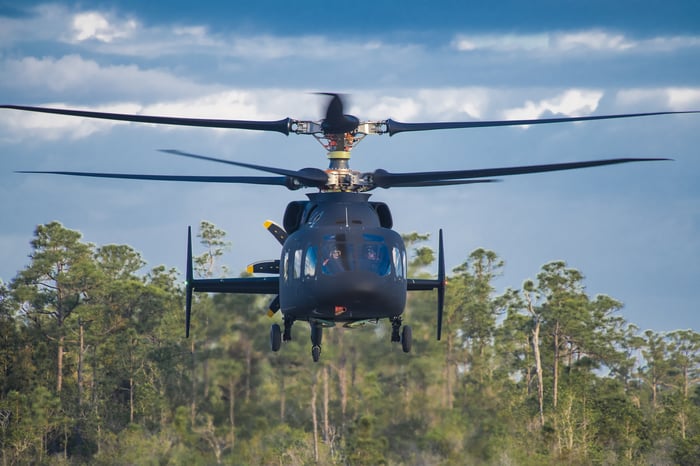A futuristic helicopter prototype developed by two of the biggest names in aerospace is finally airborne, an important milestone for a design intended to compete for upward of $100 billion in future military business.
The SB>1 Defiant, a helicopter developed by Lockheed Martin's (LMT 1.71%) Sikorsky division and Boeing (BA -0.24%), took to the skies over West Palm Beach, Florida, on March 21, hovering over an airfield for about 30 minutes. The flight was a long time coming for the Defiant, which was originally scheduled to fly in 2017 but experienced a series of setbacks during development.

The SB>1 Defiant's first flight. Image source: Boeing/Lockheed Martin.
The Defiant is part of a push to move helicopters into the 21st century. The frame has two main rotors and a rear-mounted pusher propulsor to improve stability and allow it to travel faster than conventional helicopters while retaining the helicopter's traditional hovering and low-speed operation advantages.
"Clearly, the performance, speed, and agility of Defiant will be a game changer on the battlefield, and we look forward to demonstrating for the U.S. Army the tremendous capabilities of this aircraft," David Koopersmith, vice president and general manager of Boeing Vertical Lift, said in a statement announcing the flight.
The coaxial design, with rotors spinning in opposite directions, coupled with special software counters the tendency of helicopter blades to generate uneven lift and turbulence at high speeds.
Check out the latest earnings call transcripts for Lockheed Martin and Boeing.
Two competing concepts
The Boeing/Lockheed design is one of two demonstrators participating in the Army's Joint Multi-Role technology program aimed at helping the military define what it wants from a future vertical-lift aircraft. One of the Army's top priorities has been acquiring a new helicopter that is faster, more stable, and able to haul large loads even in thin atmosphere and other extreme conditions.
The Defiant will face off in the competition against Textron's (TXT 0.78%) Bell V-280 Valor, a tilt-rotor aircraft similar to the company's popular V-22 Osprey. The Valor has been airborne since late 2017 and has been logging test flights ever since.

Artist rendering of Textron's Bell V-280 Valor. Image source: Textron.
The designs will not lead to an immediate payday for any of the companies involved, but the long-term stakes are significant. The Army over the coming decades wants to replace its massive fleet of UH-60 Black Hawk utility helicopters and AH-64 Apache attack helicopters using next-generation aircraft, and a successful demonstration now could position either of these designs for future contracts.
Overall, the Army could need as many as 4,000 medium-class helicopters at a projected price tag of $100 billion. The demonstrator effort will heavily influence the requirements for future Army rotorcraft procurement, so the better performer in this demonstration will have a strong endorsement of its technology.
Contracts on the horizon
Lockheed Martin's Sikorsky will have a chance to quickly apply what it has learned about its dual rotor technology through the Defiant in a real dogfight. The Army in October released a request for a new Future Attack Reconnaissance Aircraft (FARA), with a plan to select two bids to deliver prototypes able to fly by 2023.
Sikorsky is expected to submit a dual-rotor design that borrows from the Defiant. The Army intends to select two prototype winners that will receive about $735 million apiece by fiscal 2023 to continue development and build their design.
Video of the SB>1 Defiant's first flight. Source: Lockheed Martin/Boeing
While the Defiant is a separate aircraft, any impressions -- favorable or unfavorable -- to come out of that demonstration could influence Army decision makers considering the FARA and other future competitions. Only a handful of helicopters have ever been built using Sikorsky's dual blade technologies, and one of them, a prototype light combat helicopter, was involved in a nonlethal "hard landing" crash in 2017 during testing.
The Defiant is Sikorsky's opportunity to prove it has worked out the kinks.
Here's who wins
The payout for investors might not be immediate, but for long-term holders, the upcoming helicopter wars are worth monitoring. Assuming the Defiant testing goes well, I believe the Sikorsky design, with its helicopter-like maneuverability, is well-positioned to fill future Army reconnaissance and attack missions, while the Textron design with its airplane-like hull is a better fit for troop and cargo carrying and long-range missions.
Lockheed Martin has a chance to come out a winner no matter what happens because the company partnered with Textron's Bell unit on the Valor design before spending $9 billion to buy Sikorsky in 2015. But the allure of future contracts is why Lockheed spent big on Sikorsky, and the company will certainly want to see its wholly owned unit succeed.
Boeing is in a more complicated position, as its partnership with Sikorsky is centered on the Defiant and does not cover all the different helicopters Sikorsky has under development. Boeing-made designs including the Apache and Chinook are high on the list of programs that could be phased out in favor of new procurements.
That's all speculation for now, as the Defiant still must prove its chops. There's a lot of testing to come, but investors can at least breathe a sigh of relief now that the Defiant is finally airborne.





